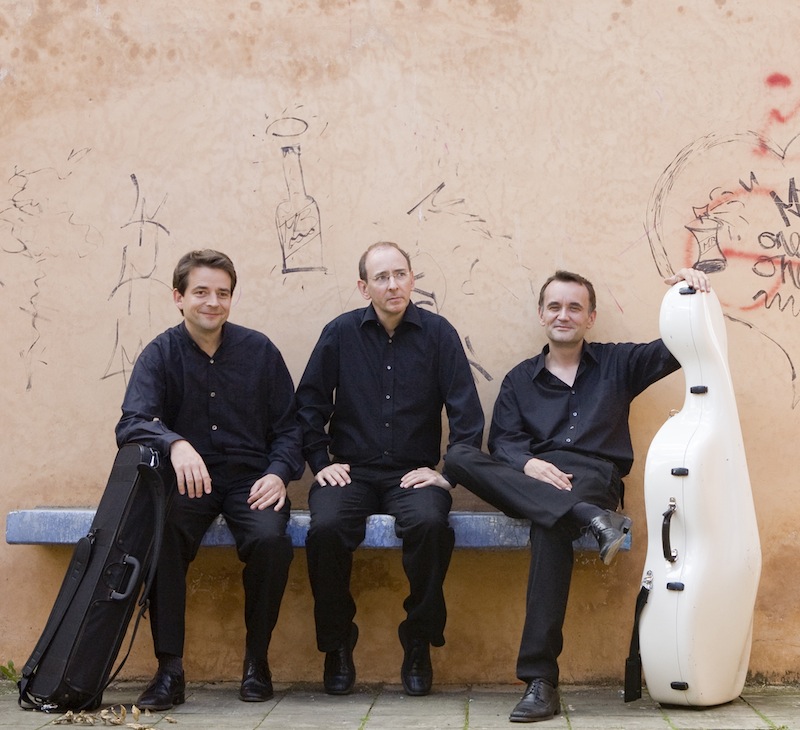Trio Jean Paul brings precision and varied hues to Celebrity Series program

Trio Jean Paul performed at Pickman Hall Wednesday night, an event presented by the Celebrity Series. Photo: Irene Zandel
The piano trio is a genre that requires a fine sense of balance and clear communication between the piano and strings. When done well, the result is listening of the most enjoyable kind.
One ensemble that has emerged on the chamber music scene for its clear conception of trio literature and depth of expression is Trio Jean Paul, which made its Celebrity Series debut Wednesday night at Pickman Hall.
The ensemble—consisting of pianist Eckart Heiligers, violinist Ulf Schneider, and cellist Martin Löhr—plays with a clean sound, technical precision, and fine communication. But the most impressive aspect of Wednesday’s performances was the trio’s expert control of timbre. The players are musical chameleons, able to change colors quickly when called upon to do so.
The piece that showed Trio Jean Paul at its darkest and most evocative playing was Wolfgang Rihm’s Fremde Szene III.
Rihm’s music combines elements of the avant-garde with a late romantic idiom. His Fremde Szenen, composed in the mid-1980s, are masterpieces of the piano trio genre. Each of the three sections mixes a sharp, dissonant language with lyrical episodes of concentrated emotionalism.
Fremde Szene III bristles with string harmonics that hover in the stratosphere, where they mesh with the light clang of piano chords. The texture is frequently broken by stirring phrases that are imbued with the romanticism of Schumann, which are followed again by stabbing dissonances.
It’s a deep, powerful work, and violinist Schneider and cellist Löhr played it with earthy tone and intensity. The robust chords from pianist Heiligers gave the music palpable weight.
Trio Jean Paul’s brightest playing of the evening came in the opener, Beethoven’s Piano Trio in E-flat major, Op. 1, No. 1. There is much to admire about Beethoven’s first published opus: the sparkling melodic lines, spring-water clarity of its textures, and the dance-like sense of rhythm. Yet this is clearly early Beethoven, and the music has a Mozartean delicacy and Haydnesque wit, though elements of composer’s mature style—surprising fortes and the sounds of digging strings—crop up here and there.
Through it all, Trio Jean Paul played with energy for a nimble, clean-cut reading. With a light touch, the musicians found the playful side of the first movement’s themes. Heiligers’ playing at the piano had a feathery quality, and his technique made easy work of the trio’s delicate runs.
In the song-like Adagio, Schneider rendered his melodies with a lemony violin tone. Löhr’s cello offered sweet-toned support, his line a fine addition to Heiligers’ left-hand figures. When the movement’s theme shifted to the minor key, the musicians played with weighty tone to give the music dark shading.
The work soon returned to the sunshine. The Scherzo was brisk and light on its feet, and the themes of the final movement were played with energy and precision.
Dvorak’s Piano Trio No. 3 in F minor, Op. 65, which made up the second half of the concert, featured Trio Jean Paul in equal parts darkness and light. Spanning forty minutes, the trio is symphonic in scope and brims with churning rhythms and themes that can change moods suddenly.
The musicians mined the pathos from the lines of the first movement. Schneider’s violin, here, sounded with vibrancy, his tone taking on just enough of an edge to make a penetrating effect.
The finely wrought finale unfolded in agitated phrases, the musicians taking care to build up to the climax that occurs by work’s end from the thinnest of textures. The second movement’s Scherzo had the rustic verve of a village band, while the Trio featured the musicians in a delicate sheet of sound. The strings sounded bright, with Heiligers’ piano supplying a music-box twinkle over static string harmonies.
But the crown jewel of the work came in the Poco Adagio, a spacious and supple movement. Löhr’s cello solo sounded with a touch of amber, and Schneider’s violin answered with phrases of tender lyricism.
The encore, the Adagio Cantabile from Haydn’s Piano Trio No. 40 in F-sharp minor, featured the ensemble in yet another color. This time it was silver, and the musicians gave the music’s gently spinning lines an elegant treatment.
The next classical music event sponsored by the Celebrity Series will feature cellist Alisa Weilerstein and pianist Inon Barnatan in music by Beethoven, Schubert, Rachmaninoff, and Hallman 8 p.m. May 1 at Jordan Hall. celebrityseries.org.
Posted in Performances




